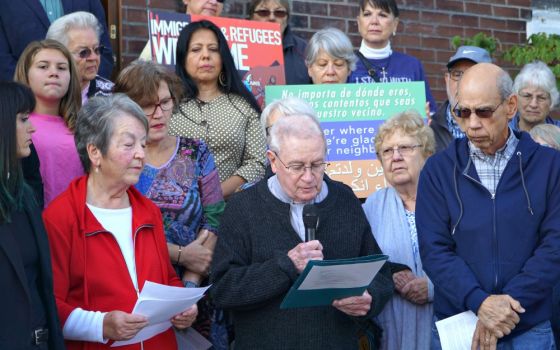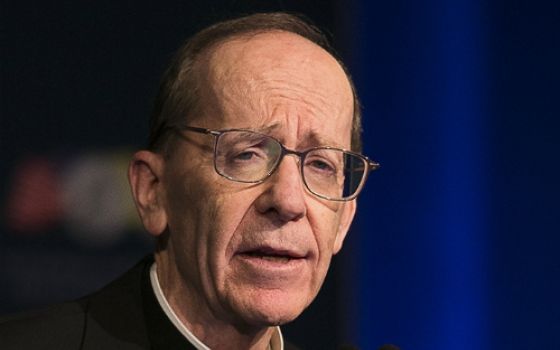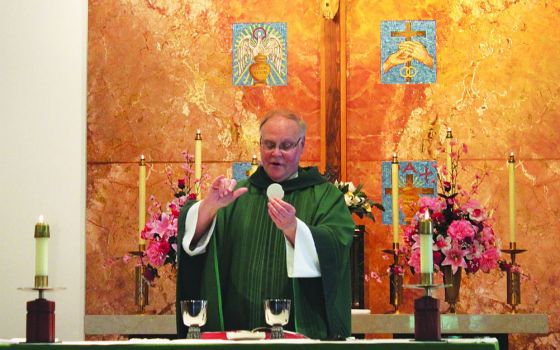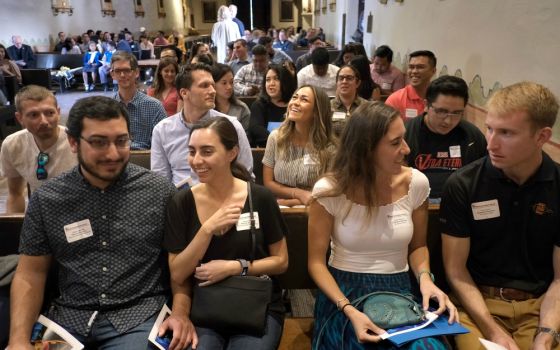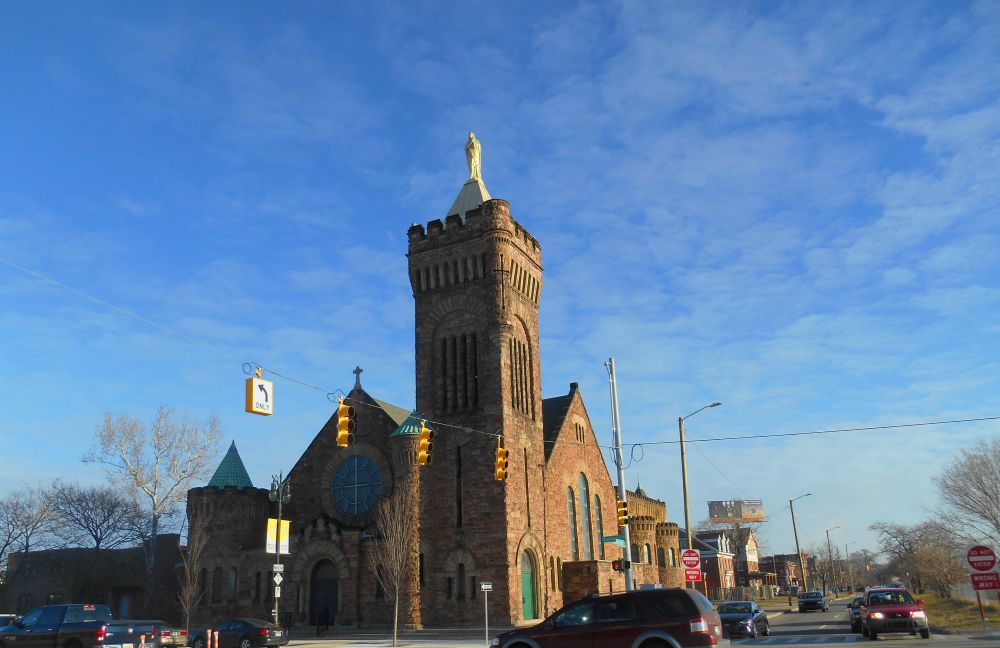
Our Lady of the Rosary Church in Detroit (Peter Feuerherd)
A gilded statue of Mary stands atop Our Lady of the Rosary Church overlooking the Ford Freeway and Woodward Boulevard in the center of this beleaguered city.
Below, Sunday Mass for the feast day of Corpus Christi commences. It begins with a congregation of 25, swelling to 35 as the Mass continues. Fr. Marko Djonovic, the parochial vicar, is preaching on the Eucharist, with a vivid depiction of the 13th-century Czech priest who inspired the feast day after he experienced the literal blood of Christ drip from the host when he offered Mass.
There is a gospel choir, consisting of a pianist, guitarist and two singers. As Mass continues, the occasional person from the streets of this Detroit crossroads neighborhood wanders in and out of the back pews.
At the sign of peace, there are hugs and greetings spread around the small congregation. They obviously know one another. The greeting sometimes turns into a quick catch-up of news.
There is obvious friendship and fellowship here, but all is not well at Our Lady of the Rosary. A visitor is greeted with the handshake of peace and is quietly told, "It was better before."
The congregation at Our Lady of the Rosary has always been small, but parishioners say that attendance at Sunday Mass is now about a third of what it used to be.
The issue, they say, is the designation last July of the parish as an oratory and the appointment of Fr. Daniel Jones as pastor. Jones is also a professor at the archdiocesan Sacred Heart Seminary.
Oratory is a concept developed by St. Philip Neri in the 16th century. It involves diocesan priests living in community dedicated to preaching and evangelization. Begun in Rome, it is now active in 15 U.S. cities, according to the Michigan Catholic the archdiocesan newspaper.
Previously, the parishioners said, the parish was focused on the neighborhood, welcoming people from the street, as well as those in nearby homes for the developmentally disabled. Now that mission outreach has been curtailed in favor of what they describe as a pre-Vatican II theology, an intent on developing a different kind of parish with few connections to the way the church has operated in the past.
"Coming here was refreshing. People were warm and inviting," Corinne Foley-Bojanic, a 32-year member of the church, told NCR. "There was a lot of community work at Woodward and I-94," she said. Along with other parishioners, Foley-Bojanic came to the parish from the suburbs, in her case Grosse Pointe, just beyond the city line. The spirit of community and outreach was inviting to those seeking a faith community, she said.
Like other Our Lady of the Rosary parishioners, Foley-Bojanic speaks in the past tense about the parish. Although she continues to be a choir member, perhaps as many as a third of the congregation has left in the past year. Some have apparently left the Catholic Church entirely. Others have moved across town to St. Charles Church, a Capuchin Franciscan community that carries on the social gospel multiracial ministry that urban Detroit Catholic parishes such as Our Lady of the Rosary have been known for.
For an outsider, the changes undergone in the parish might seem small, taken individually. But Our Lady of the Rosary parishioners, now seeing themselves as exiles at St. Charles, note a pattern that has produced widespread discontent. They trace the problems to when the archdiocese designated the parish as an oratory, a move done, they say, without consultation.
Gone are homilies dealing with social issues affecting the city and the world, such as gun violence. In their place are pious reflections on the Eucharist. The optimism Pope Francis has brought to the wider church, with a call for parishes to operate as a field hospital for the wounded and for ministers to smell like their sheep, has passed by Our Lady of the Rosary, they say.
The new oratory, which includes three diocesan priests, has eliminated Polarity, an alternative medicine program offered free to parishioners (the practitioner was told the medical approach was contrary to church teachings). The sanctuary used to be a hubbub of social events, but the new parish administration wants it reserved largely for formal church worship. An annual Valentine's Day dance for the developmentally disabled adult community had to be moved to another parish. A couple who put up Christmas ribbons to decorate the church was told to put them away last year because the colors mimicked the LGBT-rights' banner. One street person who came for Communion was denied the sacrament during Mass after he was asked if he was a baptized Catholic.
Former parishioner Fran O'Connell said the homilies began to take on a familiar message. "God was seen as a punisher. God was keeping track of all the evil we do," she said.
For Jones, the issue is one of defending church teaching and practice.
"I've got to do the Mass the way the church asks for it," he told NCR. He took out prayers that had been part of the Sunday liturgy that are not formally part of the church rubrics.
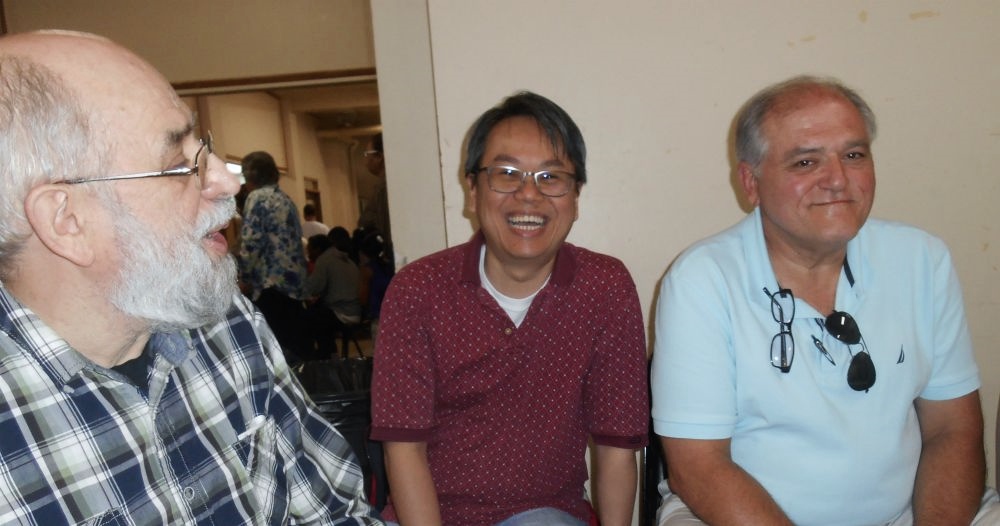
Former Our Lady of the Rosary members gather in the basement of St. Charles parish after Mass on Corpus Christi Sunday. From left, Jean Marie Allion, Wilson Suprapto and Don O'Connell (Peter Feuerherd)
As for other issues: the Polarity process is similar to reiki, he said, which a Vatican document raised questions about. A Valentine's dance is not an appropriate use for the sanctuary, he said. Students coming to Mass asked if the parish was supportive of an LGBT-rights agenda after seeing the Christmas ribbons.
As for the man denied Communion, Jones said that "we get a number of street people. This fellow was obviously disoriented." Jones said the man was given a blessing and has since returned to Mass and Communion.
The Sunday liturgy changes do "boil down to little things. But I can't say 'yes' to everything. Because I am attentive to what the church says we can do, it is upsetting to some folks."
While it wasn't evident in the Sunday morning Corpus Christi Mass, Jones said that the parish has attracted new worshipers, particularly students from Wayne State who come for a Sunday evening liturgy preceded by an hour of confessions. The total numbers, he said, have remained about the same, even with the defections.
After Mass at St. Charles, a group that used to attend Mass at Our Lady of the Rosary met at a table in the church basement. They dub themselves "Rosary Refugees."
Jean Marie Allion said that much of the message of the oratory priests was that the people of Our Lady of the Rosary "were not really Catholic" and needed a dose of more traditional values.
"We can't stay because we feel driven out," said John Bodary, another former parishioner.
The changes at Our Lady of the Rosary are part of a larger picture. Ever since 1989, the presence of the Catholic Church in the city has declined. That year, the late Cardinal Edmund Szoka shuttered 43 churches, the first widespread consolidation of parishes that has since continued throughout the Midwest and northeastern United States. The core of pastors appointed by the late Cardinal John Dearden to minister to urban parishes is now aging, with only Fr. Norman Thomas of Sacred Heart Parish still active as a pastor. Replacements have often been slow in coming.
The city itself has bled population, going from 1.8 million in the 1950s to less than 700,000 today. Many neighborhoods consist of empty lots, now overgrown with grass, broken up by the sights of abandoned houses, although there are sections that have undergone a slow revival.
One is the area around Our Lady of the Rosary. Woodward Boulevard now boasts access to three new sports stadiums and a trolley line to the nearby downtown, as well as new apartment buildings near Wayne State University. Some parishioners are suspicious that the development of the oratory is a response to the growing property values in the neighborhood. The parish itself, unlike other city parishes, is financially stable, said parishioners who were once part of a parish council that no longer meets regularly.
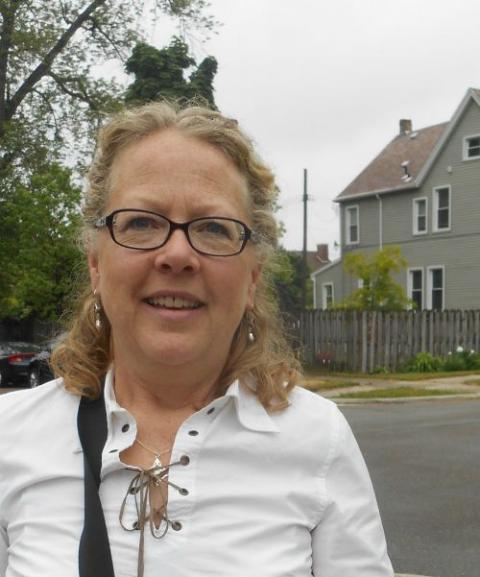
Corinne Foley-Bojanic is a 32-year member of Our Lady of the Rosary church. (Peter Feuerherd)
An article in the Michigan Catholic described the oratory approach as a way to unite priests in a community and provide more concerted outreach to the Wayne State community, as well as younger newcomers attracted to the Woodward corridor. Detroit Archbishop Allen Vigneron has proclaimed that the archdiocese is committed to a new evangelization.
But so far, say those unhappy with the oratory, the results, as seen by the barometer of Mass attendance and the number of defections, has yet to prove successful.
"It's a vision from the archdiocese that we think we are not a part of," said O'Connell.
Asked why he now attends St. Charles, former Our Lady of the Rosary parishioner John Schlitt said of his old parish, "I could not find Christ there." He's at St. Charles, he said, because "I wanted shelter."
Jones said his role is to preach salvation, "which implies that we are now in need of salvation." Unlike previous pastors, Jones said he is willing to talk about personal sin in his homilies.
"The good news is grace. It is grace for sinners," he said, acknowledging that the message has not been a popular one with some long-term parishioners.
There are few signs that the "Rosary Refugees" at St. Charles plan to return. After a year of developing the oratory, Jones remains committed to a new kind of community forged out of what remains under Mary's gilded statue.
[Peter Feuerherd is a correspondent for NCR's Field Hospital series on parish life and is a professor of journalism at St. John's University, New York.]
We can send you an email alert every time The Field Hospital is posted. Go to this page and follow directions: Email alert sign-up.
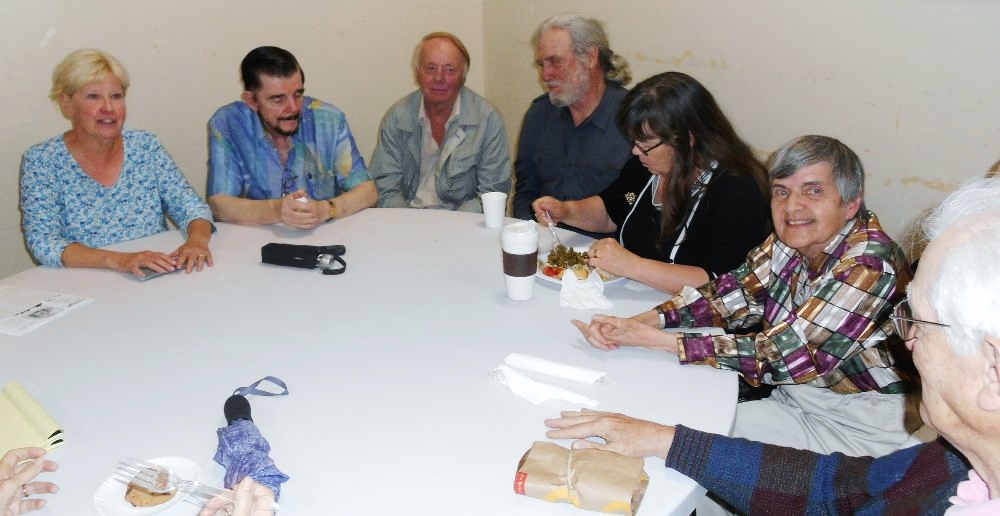
Former members of Our Lady of the Holy Rosary gather together after Mass at St. Charles Church, a Capuchin Franciscan community, June 3. (Peter Feuerherd)
Advertisement





